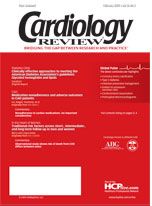Publication
Article
Cardiology Review® Online
Olmesartan medoxomil-based treatments effectively lower blood pressure
Hypertension
Results of two studies presented at the American Society of Hypertension An-nual Scientific Meeting found that olmesartan medoxomil (Benicar) and olmesartan medoxomil/hydrochlorothiazide (Benicar HCT) can effectively treat patients with Stage 1 and Stage 2 hypertension to achieve blood pressure goals.
The Benicar Efficacy in Systolic Hypertension Trial (BEST) was a 16-week, prospective, open-label, multicenter study that included 176 patients with Stage 2 hypertension (mean blood pressure 171/95 mm Hg). After a 3- to 4-week, pla-cebo run-in period, the patients (mean age 60 years) were given a 20-mg dose of olmesartan medoxomil once daily. Doses were up-titrated at 3-week intervals if blood pressure remained at 120/80 mm Hg or higher, to 40 mg olmesartan medoxomil daily, then 40/12.5 mg daily of olmesartan medoxomil/hydrochlorothiazide, and then to 40/25 mg daily of olmesartan medoxomil/hydrochlorothiazide. The primary end point was mean change in baseline systolic blood pressure at 12 weeks. The secondary end points assessed blood pressure changes from baseline after each titration period as well as the number of patients who achieved the blood pressure goal of 140/90 mm Hg or lower or normalization of blood pressure to below 120/80 mm Hg. Results showed that the 40/25-mg dose of olmesartan medoxomil/hydrochlorothiazide helped 70% of patients with a mean blood pressure of 171/95 mm Hg to reach the goal of below 140/90 mm Hg. This treatment lowered systolic blood pressure by an average of approximately 35 mm Hg.
Results of another study presented at the meeting, Treatment of Stage 1 and Stage 2 Hypertension Utilizing an Olmesartan Medoxomil-based Treatment Algorithm, also demonstrated the efficacy of olmesartan medoxomil/hydrochlorothiazide,
as well as olmesartan medoxomil. This study, a 24-week, multicenter, open-label trial, included 79 patients with Stage 1 hypertension and 100 patients with Stage 2 hypertension. Patients were started on olmesartan medoxomil, 20 mg daily, after a placebo run-in phase of up to 4
weeks. If the goal of 130/85 mm Hg or lower was not achieved, the dose was increased at 4-week intervals according to the study algorithm, using the same doses as in the BEST study for each in-
terval and adding amlodipine besylate,
5 to 10 mg daily, thereafter if needed. Of the eligible patients with Stage 1 hypertension who were taking olmesartan medoxomil or olmesartan medoxomil/
hydrochlorothiazide, 89% reached the aggressive goal of 130/85 mm Hg or lower, and of the total patients with Stage 1 hypertension, 56% reached goal on olmesartan medoxomil monotherapy alone. More than one half of the patients with Stage 2 hypertension reached goal taking olmesartan medoxomil or olmesartan medoxomil/hydrochlorothiazide.
Joseph Izzo, Jr., MD, professor of medicine and pharmacology, State University of New York at Buffalo, and a member of the executive committee of the seventh report of the Joint National Committee on Prevention, Detection, Evaluation, and Treatment of High Blood Pressure (JNC 7) commented on the results of the studies, stressing the importance of meeting goals outlined in JNC 7. The two studies demonstrate that tools are available for helping patients reach these goals, he said.
